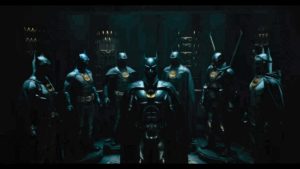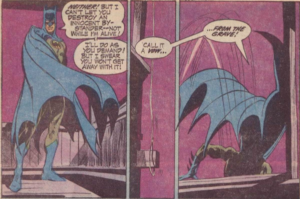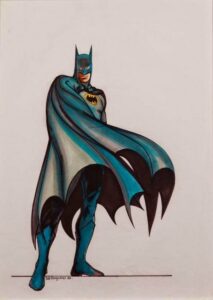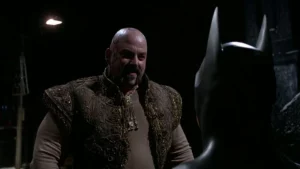Continuing the series of adapting classic Batman stories into the different movie universes, this came about as a companion piece for Case of the Chemical Syndicate. I wanted to explain the blue suit that was in the vault in The Flash.

Like I mentioned in the Chemical Syndicate commentary, I envisioned this happening within a couple weeks before Batman 89. Adapting the classic Detective Comics No. 27 story for an early case was simple enough, but how could we explain the blue suit?
The actual explanation comes from BlaidonProps, who was responsible for the blue and gray colors as well as the white lenses on the suit, citing Batman: The Animated Series as an inspiration: https://www.instagram.com/p/Cw_Ga9dKsyS/
I decided that since the 1970s comics were influential on the 89 film and that the suit looked like a Neal Adams Batman come to life, this audio should be an adaptation of something from that era. The first story I considered was Night of the Stalker, one of my favorites that Michael Uslan cited as the inspiration for the opening sequence of Batman 89 where we see a family get mugged in a similar way to the Waynes and Batman goes after the criminals responsible. But it seemed a little redundant of the Batman 89 opening and I thought it would be cool if the story explained more of the evolution into the blue costume and how it went to the classic 89 costume.
I combed through more of the Dennis O’Neil and Neal Adams stories, remembering that these were the ones that Michael Uslan shared out to Tim Burton for inspiration. In the collection of Batman in the Seventies, I came across “A Vow from the Grave.”
It had a villain who isn’t a major Rogues Gallery member, so the idea of Joker being his first supervillain in the Burtonverse could stay intact. It didn’t require Batman to be further along in his career with the police or the Bat Family yet.
The argument to use this story got stronger as I saw that one of the panels (top below) was basically traced for the Batman 89 concept art by Bob Ringwood (bottom).


Then there was the fact that Batman tricks the villain into thinking that he’s dead- something that Batman does as a tactic in the opening of 89 when the muggers shoot him and clearly something that he’s done more than once by the beginning of the film as Knox says, “They say he can’t be killed.” This story offers the possibility that Goliath was the first to mention this among the criminal underworld.
This story then turned out to be perfect. One that I could recontextualize around the idea of Keaton’s Batman deciding to become more of a creature of the night, explaining how we got from the blue costume to the one we got in Batman 89.
Our podcast Patreon patron SlightRebellionOffMadison also reminded me that “A Vow from the Grave” was loosely adapted as the Batman: The Animated Series episode, “Sideshow,” which replaced Kano Wiggins with Killer Croc, removed the murder mystery, and made Goliath a good guy. So in a way, this would also honor BlaidonProps’s BTAS inspiration, too.
On top of that, the circus characters felt like they fit the world we were presented in Batman Returns. If Chemical Syndicate had a 1989 tie-in, this one should have ones for Returns. So I made the characters connected to the Red Triangle Circus as a group that split off from Penguin. I was tempted to even make Goliath the same strongman who joins up with Penguin in the movie (with their confrontation actually being their reunion), but I’ll leave that up to the audience to decide.

While playing around with it, I also remembered that the Kenner action figure for Keaton’s Batman that came in blue and gray was the Iron Winch Batman. Thus, I threw in references to the “iron winch” whenever the grappling guns came up.

The line about the blue and gray being better camouflage at night actually comes from discussions with my podcast co-host Andrew and I where he mentioned reading that dark blue was actually said to be better camo.
At the end, I also threw in another Easter Egg from Sam Hamm, with the line about Goliath seeing his own face reflected in Batman’s lenses. This is from Hamm’s original 1986 draft for the film, where Batman was intended to have these lenses and I figured this was the main time where I could throw that in:
https://www.dailyscript.com/scripts/batman_early.html
He looks up. And sees, in the mirrored lenses where
BATMAN's eyes should be, the twin reflections of his own
stricken face.